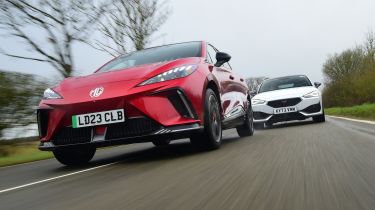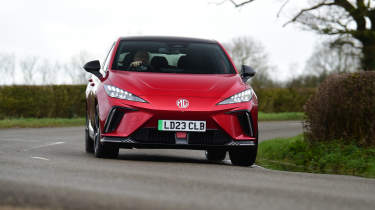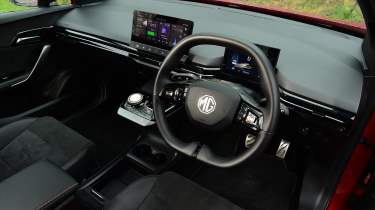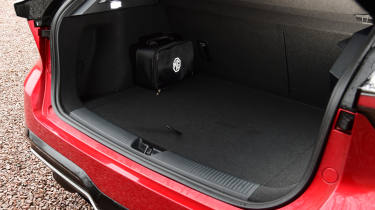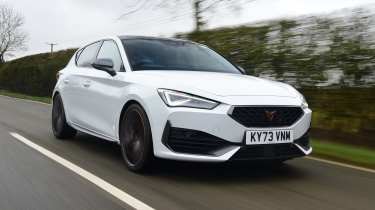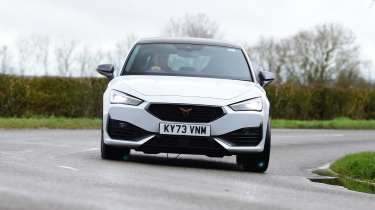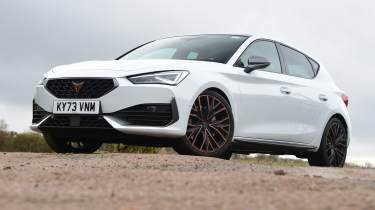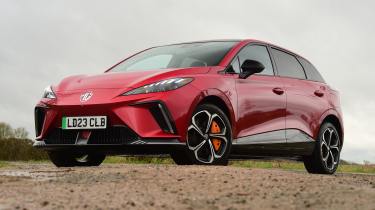MG4 EV XPower vs Cupra Leon 2024 twin test: can electric beat petrol?
Is an electric hot hatch a match for a petrol one?
Electric cars are now in a position to offer a genuine alternative to combustion-engined models in a wide variety of classes. But when it comes to performance cars, many buyers still need to be convinced that an EV can offer the same kind of thrills that a petrol-powered alternative is able to deliver.
For a hot hatchback, electric drive has its plus points. With lots of instant power on tap, a compact electric motor seems like a good fit, but this is offset by the weight of the battery in a relatively compact package, which makes it difficult for an EV to deliver the kind of nimble handling that the best hot hatchbacks offer.
MG is tapping into the sector with the new MG4 EV XPower. It’s the most powerful MG yet (until the Cyberster arrives) and gets four-wheel drive designed to help it deliver fun handling. To see if the new EV is on the right track, we’re comparing it with the Cupra Leon. This 2.0-litre turbocharged front-wheel-drive petrol machine is about as traditional as a hot hatch as it gets. Does that give it a natural advantage?
| MG4 EV XPower | Cupra Leon VZ2 Design Edition | |
| Price: | £36,495 | £40,950 |
| Powertrain: | 2x e-motors, 429bhp | 2.0-litre 4cyl turbo petrol, 296bhp |
| 0-62mph: | 3.7 seconds | 5.7 seconds |
| Test efficiency: | 3.3mi/kWh | 29.8mpg/6.6mpl |
| CO2: | 0g/km | 173g/km |
| Annual VED: | £0 | £570 |
MG4 EV XPower
We’re fans of the standard MG4 because it’s one of the best-value ways to get into electric vehicle ownership. Does the package still stack up when it’s sprinkled with a bit of hot-hatch magic? At £36,495, it undercuts the Cupra Leon by £4,455.
Tech highlights
One change that MG has made to turn the MG4 into a hot hatch is to more than double its power output. There’s a massive 429bhp on offer, which is a whopping 133bhp more than the Cupra Leon, and is even ahead of the UK’s most powerful petrol hot hatch, the 416bhp Mercedes-AMG A 45 S.
Used - available now

2016 Tesla
Model S
78,000 milesAutomaticElectric
Cash £18,999
2024 Audi
A3 Sportback
50,864 milesAutomaticPetrol1.4L
Cash £23,497
2022 Audi
A4
22,003 milesManualPetrol2.0L
Cash £23,000
2024 SEAT
Arona
7,908 milesAutomaticPetrol1.0L
Cash £16,200However, rather than just crank up the standard car’s rear-mounted electric motor, MG has added a second unit to the front axle, so the XPower comes with four-wheel drive.
Other updates under the MG’s skin include recalibrated springs and dampers, stiffer anti- roll bars and sharper steering, while electronic assistance comes in the form of launch control and a Dynamic Cornering Control System that adds an electronic diff lock and torque vectoring to send power to the wheels with the most grip. The regenerative braking system has been revised to include one-pedal driving, while new 18-inch wheels are fitted with Bridgestone Turanza rubber.
One thing that hasn’t changed is the MG4’s battery, because the XPower has the same 64kWh pack as the Long Range model.
Safety: The MG4’s five-star safety rating earned in 2022 also applies to the XPower variant, while the flagship comes with the MG Pilot suite of safety equipment as standard. This includes advanced kit such as blind-spot detection, assistance when changing lanes, rear cross-traffic alert for reversing and a door-opening alert that activates if you’re about to open a door on approaching traffic.
On the road
The XPower is a rocket in a straight line, but it doesn’t have the finesse in corners to stand out as a great hot hatchback.
Around town: While 429bhp is a lot of power to manage, there’s plenty of travel in the MG4’s throttle, so it’s easy to drive smoothly without tapping into its vast reserves. MG quotes a 0-30mph time of 1.7 seconds, so it should be strong off the line.
As already mentioned, there’s one-pedal driving on offer, and the car’s energy recovery is smoother to use than the mechanical discs and brakes. There are 345mm vented discs all round, but they tend to grab quite harshly compared with the regeneration, so there’s a distinct step in braking performance.
A & B-roads: From a standing start up to the national speed limit, the MG4 XPower is a little unruly. The wallop of acceleration sees the car pitch back on its suspension and the front wheels momentarily lose traction, which is an odd sensation in a four-wheel-drive car. There’s also some torque steer to fight through.
Once you’re up to speed, however, the XPower feels reasonably agile and well balanced front to rear, and it hides its 1,800kg kerbweight well. There’s plenty of grip on offer, too, but the hottest MG4 doesn’t feel particularly involving, thanks to the lifeless steering.
Trail brake or lift off in the middle of a corner and it’s possible for the rear to move around, but we think the rear-wheel-drive MG4 is more playful to drive than this AWD version.
Motorway: The XPower remains firm but not harsh at higher speeds, while most of the noise at a motorway cruise comes from the tyres.
Ownership
A hot hatchback needs to have a sense of occasion, but it’s something the MG4 XPower lacks. The dashboard layout is identical to the standard car’s, with the only additions being the part-fake leather/Alcantara sports seats, metal pedals and an additional menu for the central touchscreen that shows driving information.
There are hard plastics on show and some gloss-black trim on the dashboard, floating centre console and steering wheel, while Audi-like column stalks are a highlight. However, the other switchgear feels a bit flimsy, and our car had a couple of creaks emanating from the dashboard. There are a pair of USB ports up front, but they’re not illuminated and are otherwise difficult to access beneath that drive-selector housing.
The front seats are fairly comfortable but they don’t have a big range of adjustment, while rear visibility is compromised by the small back window and large rear headrests.
The MG’s standard-fit climate control and heated seats aren’t consistent in their operation, either – cold draughts could be felt around the cabin, while the seats changed temperature from warm to fiery even in the lowest setting.
We found the air-conditioning used quite a lot of energy, too, trimming the car’s range by around an eighth on a motorway run. At least charging is decent, with a maximum rate of 113kW seen at a fast charger, although this tails off to around 50kW when the battery is at 80 per cent capacity.
Storage: With less space needed for their mechanical parts, most EVs offer good cabin space and storage, but the MG4 could be better. While the centre bin beneath the armrest is deep, the covered tray ahead of it is large but shallow and
the glovebox is quite slim, too. At least the twin cup-holders ahead of that are deep, while the door bins have space for bottles.
Practicality
Battery location creates a spacious interior, but there are compromises, too.
Rear Space: Both cars have enough space for three adults to sit across the back, shoulder to shoulder. But there’s a high floor in the MG and not much foot space under the front seats, so this pushes your thighs up and limits support. The Cupra, on the other hand, has more foot room, so it feels more comfortable.
Boot: The MG has to make room for its electric powertrain under the boot floor, and the overall capacity of 363 litres is 17 litres behind that of the Cupra. However, the XPower has a lower load lip that sits level with the boot floor, so stowing heavier items is easier. The back seats fold to create 1,165 litres of space, which again is less than you’ll unlock in the Leon, but the rear seats fold completely flat, boosting accessibility.
What to buy?
Which engine and trim we’d choose…
- Powertrains: Given that the XPower is the flagship of the MG4 range, it’s the only one that uses the 429bhp twin electric motor set-up, and is therefore the only version of the hatch that has four-wheel drive. It’s also the only MG4 to come with launch control.
- Options: The only extras available are the exterior colours. Arctic White and Holborn Blue are the no-cost options, while Black Pearl, Camden Grey, Volcano Orange and our car’s Dynamic Red cost £695 each. Exclusive to the XPower model is Racing Green metallic, which is slightly more expensive, at £800.
- Our choice: Pick a favourite colour and the MG4 XPower is ready to go.
Cupra Leon
The Cupra badge started as the identifier for SEAT’s performance models, with the Leon as its challenger in the hot-hatch class. Now the Cupra Leon is its own model, with the 296bhp 2.0-litre turbocharged model leading the range.
Tech highlights
With no electrification, not even a mild-hybrid system, the Cupra Leon is very much a traditional petrol-powered hot hatchback. It’s powered by the Volkswagen Group’s renowned EA888 turbocharged four-cylinder engine, a unit that has seen service for a number of years in sporty models such as the Golf GTI and Golf R, Skoda Octavia vRS and Audi S3 and TT.
While previous generations of SEAT Leon Cupra offered the option of a manual gearbox, the Cupra Leon is automatic only. It’s a seven-speed twin-clutch DSG unit, and it sends power to the front wheels: four-wheel drive is reserved for the Cupra Leon ST estate. There are Standard and Sport modes for a more aggressive shift, or you can use the steering wheel-mounted paddles.
As with the MG, there are electronic driver aids that are designed to help make the most of the Cupra Leon’s performance. Launch control is fitted as standard, while the XDS electronic differential lock applies braking to the inside wheel to help the Leon keep a tight line through corners.
Safety: The Leon earned a five-star Euro NCAP rating – the same as the MG – but the Cupra was tested in 2020, so the scores for both cars can’t be directly compared. Since the Leon is an older design, it doesn’t feature the kind of speed-limit warning that is now compulsory on all new cars, but the other safety systems are a bit aggressive in their operation. Lane assist tugs at the wheel when active, for example, but it can be turned off easily.
On the road
With less power to deal with, the Leon feels like a better all-round package than the MG4.
Around town: Thanks to fast steering and compact dimensions, the Cupra Leon is a cinch to drive around town, while the front and rear parking sensors, plus a reversing camera, mean low-speed manoeuvres are a breeze.
The ride is on the firm side and picks up every bump in the road, but it’s not harsh. Those big wheels tend to crash into potholes, though.
A & B-roads: Where the Leon really pulls ahead of the MG4 is with its agility. A 1,504kg kerbweight means it’s nearly 300kg lighter than its rival here – the equivalent of taking two extra passengers with you every time you head out in the MG4 – and this translates into a far more entertaining drive.
The MG’s extra weight comes from its battery, but while this is all located low down beneath the cabin, it’s the Cupra that feels like it carries its mass closer to the floor. There’s less body roll and the car is keener to change direction, all the while feeling better tied down than the MG. The steering isn’t packed with feedback, but it’s precise and loads up through the corners..
In a straight line the Cupra Leon’s 0-62mph time of 5.7 seconds is rapid, but it’s still two seconds slower than the MG’s. However, the launch-control system is effective, and the sound of the four-cylinder engine racing through the revs adds some aural drama when compared with the MG’s clinical electrical efficiency.
Motorway: At a high-speed cruise the Leon’s engine drones a little, but the Cupra feels stable and more refined than the MG.
Ownership
Inside, the Leon is a cut above its rival when it comes to finish and how special it feels. You’re hugged by some wonderfully supportive sports seats up front, while ahead of you there’s a smart steering wheel that’s great to hold and has big, physical buttons to make changes to the cruise control, audio settings and the digital instrument panel. Fit and finish is great, and there are enough sporting flourishes to make the cabin feel special.
Since we ran a Leon TSI 300 on our long-term fleet in 2022, Cupra has introduced a few features previously missing that bugged us at the time. European-spec cars included a useful steering wheel-mounted button to scroll through the various drive modes and another on the centre console to ease the intervention of the stability control system – features which previously were only available on the 310 estate in the UK. This has now changed for the better, allowing drivers to make these changes easily on the fly.
While Cupra didn’t feature in our Driver Power customer-satisfaction survey for manufacturers, its parent group SEAT did. Its final placement of 23rd isn’t particularly impressive, but it’s still well clear of MG’s final position. Of those buyers surveyed, 21 per cent experienced a fault of some sort (half of which were electrical gremlins), which made SEAT the 11th most reliable brand overall.
If the worst does happen, Cupra offers two years’ breakdown cover as standard with every new car. The three-year/60,000-mile warranty package can’t match MG’s seven-year/80,000-mile cover.
Storage: The Cupra’s wireless smartphone charging shelf is angled downwards and forwards in the centre console, which is a much more sensible design than the MG4’s. Further back, there are a pair of cup-holders and a deep central storage bin. The door bins are also wider and deeper than the MG’s up front.
Practicality
As with the best hot hatches, the Cupra Leon mixes performance with usability.
Rear Space: The Cupra pips the MG4 for knee and headroom. Without the need to fit a thick battery pack, there’s a larger gap between the seat base and the floor, which opens up more space for feet beneath the front seats. The chairs themselves are more comfortable, too, while the wide and flat centre seat is reasonably comfortable for a third passenger.
Boot: At 380 litres, space is on the money for a five-door hatchback. There’s no false floor, as there is in the MG, so the base of the load area is quite deep, but when combined with a high load lip, it means there’s quite a step over which to load heavy items. That aside, the space is square, with minimal intrusion. There’s a 60:40 split in the back seats, plus a load-through hatch for longer items.
What to buy?
Which engine and trim we’d choose…
- Powertrains: When the SEAT Leon Cupra became the Cupra Leon, the line-up expanded to offer additional powertrains. At the entry point is a 1.5 TSI, while a 1.4 PHEV is also offered. At the top of the range there’s a choice of the 296bhp 2.0 TSI tested here, or a 242bhp 1.4 e-Hybrid plug-in.
- Trim: There are VZ2 Design Edition and VZ3 Design Edition trim levels to choose between, with the latter costing £3,345 extra in 2.0 TSI guise. This adds Nappa leather bucket seats, copper detailing inside and out, and a heated steering wheel with additional buttons.
- Our choice: The VZ2 is mechanically identical to VZ3, but lacks some sporty touches.
Results
Which car comes out on top?
Winner: Cupra Leon
It’s more expensive to buy and run, but the Cupra Leon offers the kind of performance that’s worthy of the hot-hatch label. There’s lots of power from the turbocharged engine, and the chassis is able to cope with it, too.
The Leon is a great all-rounder, and it delivers sharp responses and a level of involvement that mean, while the MG4 will leave it for dead on the straights, the Cupra driver will have more fun trying to play catch-up in the corners. The Spanish contender also feels more like a premium product than the MG.
| Pros | Cons |
| Engaging handling | Pricier than MG to run |
| Punchy petrol engine | Fake engine sounds |
| Purposeful looks |
Frustrating infotainment |
| Practical cabin | Three-year warranty |
Runner-up: MG4 XPower
The MG4 XPower proves that bunging a massive power output in a hatchback doesn’t necessarily make it hot. Yes, it’s ferociously fast in a straight line, but it feels unruly and there’s no finesse in the way that it handles its power.
Although the XPower costs less than the Leon, the price premium it carries over the rest of the MG4 range is difficult to swallow when it looks largely the same inside and out. We’re still fans of the MG4, but it makes more sense in a lower spec.
| Pros | Cons |
| Mind-bending acceleration | Uninvolving to drive |
| Lots of grip | Inconsistent braking |
| Practical interior | Cabin quality |
| Low running costs | Rear visibility |
Rivals and other options
The Leon wins our twin test, but what else is out there?
- Same money: Smart #1
- Same class: Ford Focus ST
- Used: Mercedes-AMG A 45 S
- Used: Tesla Model 3
- Coming soon: Alpine A290
The great debate
What the Auto Express test team would do…
John Mcllroy, editor–at–large: “If you like the idea of the Cupra Leon, but want lower running costs, then the 245bhp e-Hybrid model might be the one for you. The extra weight of the plug-in powertrain means it’s not quite as focused as the 2.0 TSI, but it’ll be cheaper to run in everyday use.”
Richard Ingram, deputy editor: “If you need more space than the Cupra Leon has to offer, you can shell out for the estate model instead. As well as the added versatility of a larger boot, it also comes with more power – up from 296bhp to 306bhp – while four-wheel drive is added for greater all-weather ability.”
Dawn Grant, picture editor: “For a car with more than 400bhp, the MG4’s styling doesn’t exactly shout about its performance. Some people will love the subtlety, but we can’t help but think it could be toughened up a little more with a different spoiler, larger wheels and a more dramatic bodykit.”
Dean Gibson, senior test editor: “The MG4 is proof that raw speed is absolutely no guarantee of actual fun. If
I wanted an EV that would put a smile on my face, I’d much sooner turn to the less powerful and more playful standard MG4, and I’d have an extra wad of cash left over, too.”
Which would you buy? Let us know in the comments section below…
Specs and prices
| MG4 EV XPower | Cupra Leon VZ2 Design Edition | |
| On the road price/total as tested | £36,495 / £37,190 | £ 40,950 / £ 40,950 |
| Residual value (after 3yrs/36,000) | £ 18,868 (51.7%) | £19,369 (47.3%) |
| Depreciation | £17,627 | £21,581 |
| Annual tax liability std/higher rate | £145.76 / £291.5 | £2929.29 / £5,858.6 |
| Annual elec. or fuel cost (12k/20k miles) | £ 891 / £1,485 | £2,658 / £4,430 (Petrol) |
| Ins. group/quote/VED | 40/ £1,849/ £ 0 | 30/ £1,540 / £ 570 |
| 3-year service cost | £98/ £191/ £98 | £799 |
| Length/wheelbase | 4,287/2,705mm | 4,398/2,689mm |
| Height/width | 1,516/1,836mm | 1,442/1,799mm |
| Powertrain | 2x electric motors/lithium-ion battery | 4cyl in-line turbo petrol/1,984cc |
| Peak power/revs | 429bhp | 296bhp/5,300rpm |
| Peak torque/revs | 600Nm | 400Nm/2,000rpm |
| Transmission | Single-speed auto/4WD | 7spd auto/fwd |
| Battery capacity or fuel tank size / usable | 64/ 61.8kWh | 40 litre fuel tank |
| Boot capacity (seats up / down) | 363/1,165 litres | 380/1,301 litres |
| Kerbweight/payload/towing weight | 1,800/461kg/N/A | 1,504/496/1,800kg |
| Turning circle/spare wheel | 10.6 metres/repair kit | 10.5 metres / space saver |
| Basic warranty (miles)/recovery | 7yrs (80,000)/1yr | 3yrs (60,000)/2yrs |
| Driver Power manufacturer position | 32nd | 23rd (SEAT) |
| Euro NCAP: Adult / child / ped. / assist / stars | 83/80/75/78/5 (2022) | 91/88/71/80/5 (2020) |
| 0-62mph / top speed | 3.7 seconds / 124mph | 5.7 secs / 155mph |
| Auto Express economy(miles/kWh)/predicted range | 3.3 / 204 | 29.8 mpg / 262 miles |
| Claimed range (WLTP) | 239 miles | 37.2mpg |
| Charging capability | 7/50/150kW | N/A |
| Charging time | 8h 30 min/52 min/35 min | N/A |
| Actual/claimed CO2/tax bracket | 2% | 219 / 173g/km / 37% |
| Number of airbags / Isofix points | Six/two | Six/three |
| Parking sensors/camera | Front & rear/360 degree | Front & rear/yes |
| Lane-keep assist / blindspot / AEB | Yes/yes/yes | Yes/yes |
| Climate control/adaptive cruise ctrl | Yes/yes | Three-zone/yes |
| Leather / heated seats / wheel | Alcantara/front/yes | Yes/front/yes |
| Metallic paint/LED lights | £545/yes | £630/yes |
| Keyless entry & go/powered tailgate | Yes/yes | Yes/no |
| Sat-nav/digital dashboard/USBs | Yes/yes/three | Yes/yes/four |
| Online services/wireless charging | Yes/yes | Yes/yes |
| Apple CarPlay/Android Auto | Yes/yes | Wireless/wireless |

